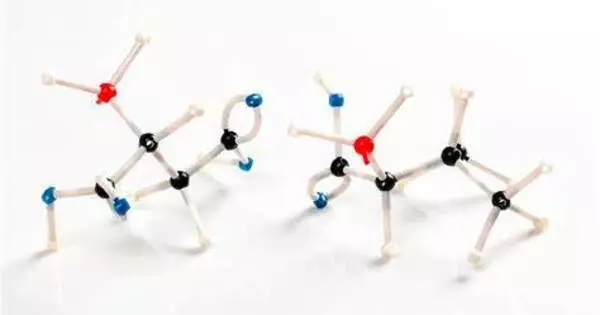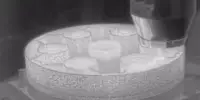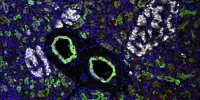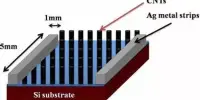Spontaneous assembly of 3D objects from building blocks in fluids can occur via a variety of processes, which are frequently governed by physical and chemical principles. Chemical engineering researchers used fluid mechanics, chemo-mechanical processes, and a little stickiness to overcome the challenge of designing such properly self-aligning structures.
Automating the construction of tens of millimeter-sized three-dimensional structures would revolutionize the manufacturing of devices for optical, electrical, and biomedical applications. A cost-effective method for creating such 3D microstructures would be to “program” the constituent parts to spontaneously come together and build the structures. However, getting micron to mesoscale components (roughly 0.1 to 100 millimeters) to line up and dynamically assemble into the desired structures remains a challenge.
Chemical engineering researchers at the University of Pittsburgh Swanson School of Engineering have built upon their previous research to overcome the challenge of designing such properly self-aligning structures by using fluid mechanics, chemo-mechanical processes – and a little stickiness.
One of the fundamental challenges in building anything with micron-sized building blocks is getting the blocks to robustly organize on their own, with little intervention from external tools, which could interfere with the dynamic self-assembly.
Anna Balazs
Their research, “Engineering confined fluids to autonomously assemble hierarchical 3D structures,” was published in PNAS Nexus. Lead author is Oleg E. Shklyaev, post-doctoral associate with Anna Balazs, Distinguished Professor of Chemical and Petroleum Engineering and the John A. Swanson Chair of Engineering, with former post-doc Abhrajit Laskar.
“One of the fundamental challenges in building anything with micron-sized building blocks is getting the blocks to robustly organize on their own, with little intervention from external tools, which could interfere with the dynamic self-assembly,” Balazs explained. “What’s wonderfully brilliant about the system that Oleg designed is that the naturally occurring interplay between the fluid and chemistry performs the work to spontaneously construct a robust system.”
Shklyaev created two-dimensional polymeric sheets using computer modeling, with one heavier sheet serving as the foundation or base and the other lighter sheets serving as construction panels. Sticky bonds are added to specific points on the sheets to act as hinges, similar to how DNA molecule bonds (A,C, G, T) are designed to fit together precisely.

The panels are then dropped into a solution and sink to the bottom of the tank in random locations. The addition of a reactant to the solution causes a catalytic reaction, which produces fluid flows with vertical and horizontal velocities to the confining walls. The sheets are first moved together along the chamber floor by the horizontal flow, and the sticky bonds connect the appropriate panel to the base. The vertical flow then lifts the structure’s sides into an upright position, where the panels are again connected via sticky bonds to complete the structure.
“The system’s inherent property is the conversion of chemical energy (released from the catalytic reaction) into mechanical action (fluid flow).” As a result of the catalytic reaction converting reactants into products, density or concentration gradients in the solution are produced. In turn, the gradients generate a force that acts on the fluid and causes it to flow. The flow acts as “helping hands” to assemble the structure, according to Shklyaev.
“Through chemistry, you can engineer the spatially and temporally varying patterns that emerge in the flow, and thereby tailor the work done by these hands, which also initiate the cascade of events that leads to building a regular tetrahedron, cube, or similar structure. In principle, the “sticky” bonds on the panels can involve strands of DNA; the complementarity of DNA strands enables the bonds to be highly selective and recognize the regions to which it should stick.”
Closing the Lid on the Experiment
By engineering the fluid flows, Shklyaev could drive the self-organization of a cube and the closing of the cube’s lid, so that the entire structure resembled a takeout box. The chemically generated fluid flow acting on the panels (through mechanisms knows as solutal buoyancy and diffusioosmosis) eventually reaches a dynamic steady state as it completes the assembly of the object, which could later be removed out of the fluid and maintain its integrity.
To emphasize the potential of the fluidic machinery, the tops of each panel were decorated with long whiskers. As the panels fold upward and the whiskers extend into the fluid flow, the resulting forces cause the whiskers to rotate, much like moving propellers. Sticky bonds could be added to the whiskers to attract bacteria or other materials that need to be removed from the system.
“The use of chemical reactions to tailor the flow to act as a mechanical tool has not been widely applied in human-made systems, but is particularly valuable because the fluid flow performs the necessary work and replaces complicated machinery,” Balazs said. “The process is scalable; multiple structures of various shapes can be formed at the same time.”
















